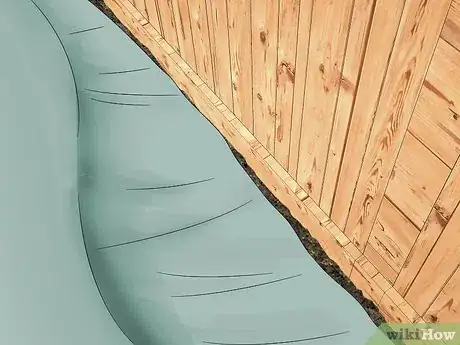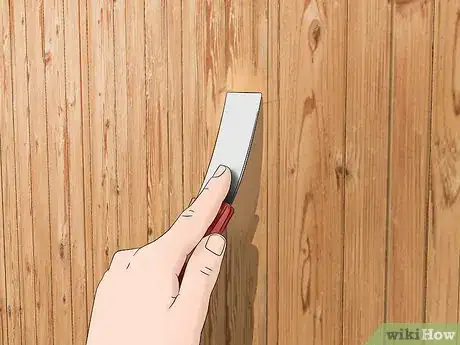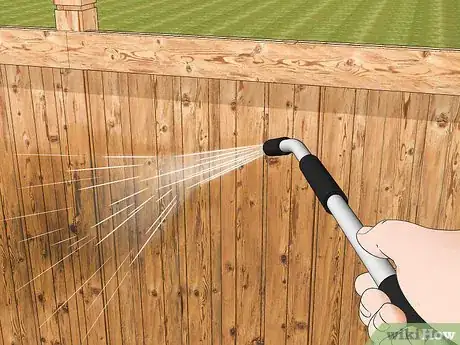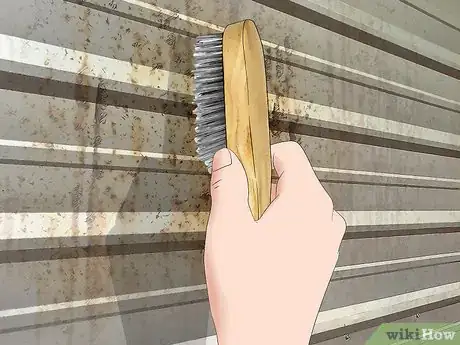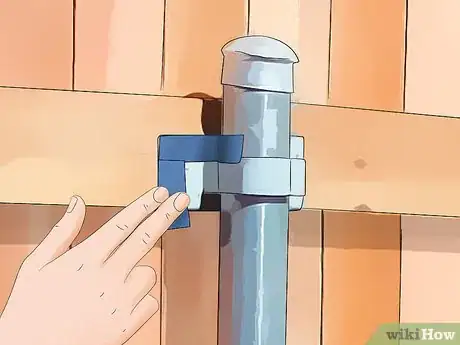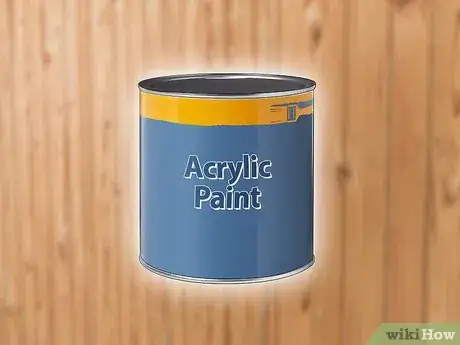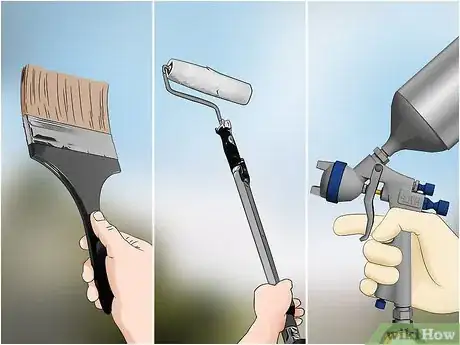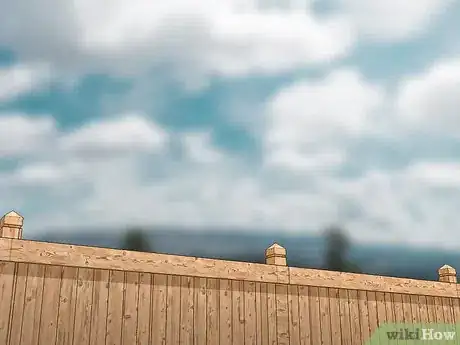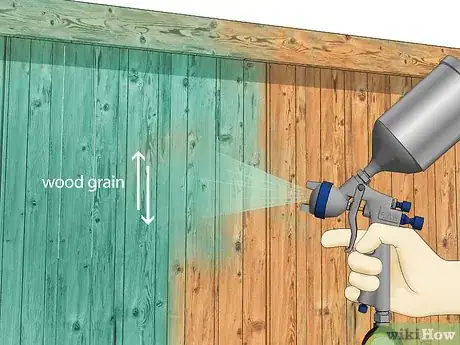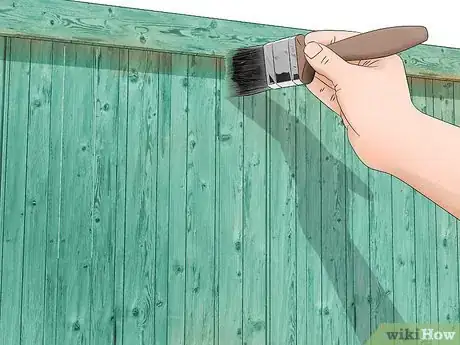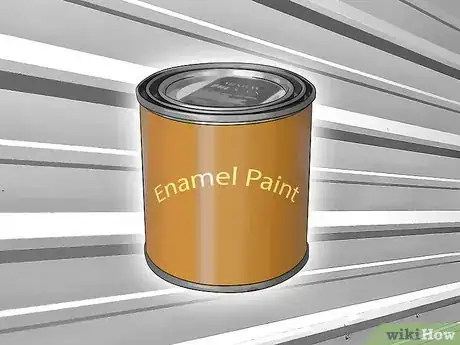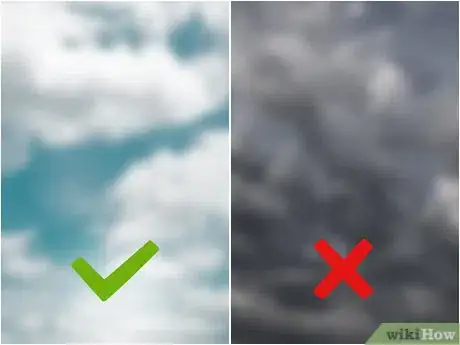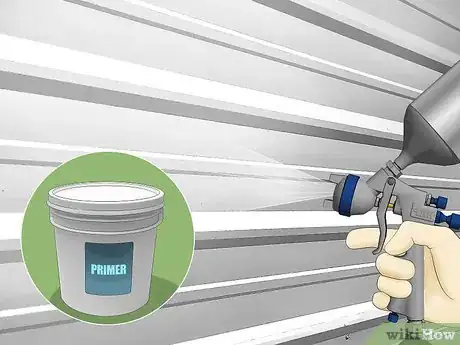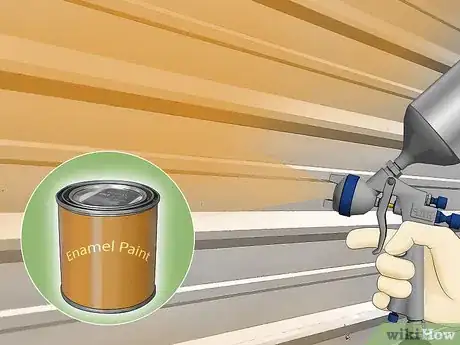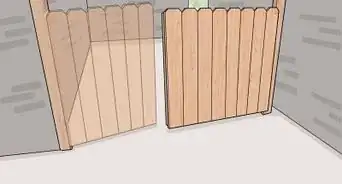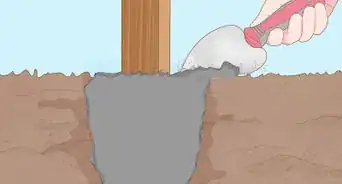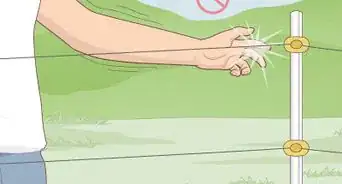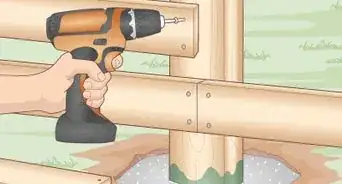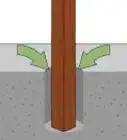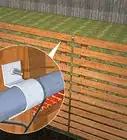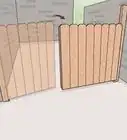This article was co-authored by Andres Matheu. Andres Matheu is the Owner of Hömm Certified Painting Systems, an Interior and Exterior Residential painting business based in the Washington, DC Metro area. Andres specializes in interior and exterior residential painting, color consultations, cabinet refinishing, wallpaper removal, and epoxy flooring among other services. An EPA Lead-safe Certified Firm, Hömm Certified Painting Systems has been awarded the Best of Houzz 2019 Service, Angie's List Super Service Award 2019, and Northern Virginia Magazine's 2018 Best Home Experts (painters) award.
There are 11 references cited in this article, which can be found at the bottom of the page.
This article has been viewed 293,339 times.
Paint can revitalize an old fence or give a wonderfully crisp finish to a new fence. Besides its cosmetic effects, paint provides the fence with protection against the elements. However, fence painting is a time-consuming undertaking, so it’s important to do it correctly so that your work lasts for as long as possible. By preparing the area and the fence properly, using the correct paint and tools, and applying your coats correctly, you can make your fence look wonderful and reduce the likelihood that it needs to be replaced as well.
Steps
Masking Off the Area
-
1Cut or tie back any vegetation that is making contact with the fence. Mow and edge the grass along the fence line. Trim back bushes and shrubs that touch the fence. If you don’t want to trim them, use twine to tie them away from fence.[1]
- Pulling vegetation away from the fence gives you space to work, protects the plants from being covered by paint, and reduces the risk of your newly painted surface being blemished by plants rubbing against it.
- Be sure to look for any vines that might be growing along the fence, as well.[2]
- You can use a leaf blower to blow dirt and grass clippings away from the fence line.
-
2Mask off plants around the fence. You want to protect the vegetation along the fence line while readying the surface for painting. Put plastic sheeting or a drop cloth over plants that might accidentally get paint on them. Just be careful to make sure that the plant can handle the weight of whatever masking you use.[3]
- You can also slide a sheet of plywood between your fence and shrubs. This protects the vegetation from paint toxins. When the surface has dried, pull out the plywood and the shrub will likely snap back naturally.
Tip: Preparation is a critical phase of fence painting. This is a time-consuming process, but it makes the job easier in the long run.
Advertisement -
3Spread a drop cloth or plastic sheeting under the fence. This will protect the ground from being covered in drips or sprays of paint. Keep it in place throughout the project so it will collect residue from prep work and protect against spills.[4]
- You can use either a cloth or plastic drop cloth for this job.
Repairing and Masking Off the Fence
-
1Make repairs to the fence. If you are going to take the time to paint a fence, it’s a good idea to get the fence in good shape before you do it. Replace any boards or rails that are broken beyond repair. If there are small cracks in wood boards, you can use wood glue to repair them. Also remove and then replace any loose nails, screws, or bolts.[5]
- If you are painting a metal fence, consider having any broken areas re-welded or re-fabricated before painting.
-
2Pressure-wash or sand a wood fence. New, untreated fences can be either pressure washed or sanded. It's best to sand a wood fence that was painted before, in order to remove any old, loose paint. This helps the new paint adhere to the wood.[6]
- If the fence has already been painted, pressure wash it first to remove any dirt, grease, or debris from the surface. Then, sand the fence to remove any wood splints.[7]
- You may also want to use a scraper to remove any peeling paint from the surface of the fence. Do this before you wash and sand it.[8]
- If you are sanding a previously painted fence, it’s important to wear breathing protection while you work.
- Let the surface dry completely after pressure washing or scrubbing the fence before painting.
Tip: Sometimes even pressure washing and sanding won't kill all the mold that has appeared on a wood fence. To get rid of it, use a scrub brush and a 1-to-1 mixture of bleach and water and scrub the surface.
-
3Remove loose paint and rust from a metal fence. If you're painting iron or metal fencing, use a steel brush to remove light areas of rust and loose paint. If there are areas that are extremely rusty, you can use naval jelly to dissolve the rust. Then sand the entire surface with medium-grit sandpaper.[9]
- After sanding, wipe off residue with a clean rag.
- It’s important to wear breathing protection while sanding your metal fence. Pick a facemask that can protect you from the dust you are creating.
-
4Tape off parts of the fence you don't want to paint. Use painter’s tape to keep paint off of any areas that shouldn’t be painted. This typically includes things like ornaments, gate latches, and handles and other hardware.[10]
- There is painter’s tape that is made specifically for outdoor applications. It will stick better to parts of your fence than the type that is made to be used indoors.
Painting a Wood Fence
-
1Pick the right paint for your wood fence. When painting a fence you need to use outdoor paint. These are specially treated to withstand the effects of weather and come in a variety of types:[11]
- Acrylics: Acrylic paint is durable, providing an excellent layer of protection for your fence, but you might have to apply a primer to an untreated surface before you can paint.
- Oil-based outdoor paint: Oil-based paints may require multiple coats and may not protect as well as acrylics, but they do provide a superior-looking finish.
Tip: Talk to your paint supplier about how much paint you'll need to complete your job. Be prepared to tell them the square footage of the fence.
-
2Choose to use a brush, roller, or sprayer, or a combination of all three. What you choose typically depends on how much fence you need to paint. However, you should also consider what type of paint you’re using and how detailed the work will be. For example, some paints are formulated to be used with either brushes or sprayers and state so on their labels.
- Use a sprayer for a long fence or a fence with lots of cutouts or spots that will be hard for a brush to get into. If you have a long fence, you probably will want to use a sprayer because it will allow you to complete the job quickly. A sprayer is also good at getting into every crevice, so use one if your fence has detailed scrolling work.
- If you have a smaller project, such as a short section of fence, you probably can complete the job using a roller on flat surfaces and a brush for detailed, inside sections.
-
3Pick a suitable day to do the painting. Certain weather conditions are ideal for fence painting. Pick a day with no rain in the forecast. Also, try to paint on a day with calm winds and ample cloud cover.[12]
- Breezes can kick up debris that can stick to your paint job.
- Direct sunlight makes the paint dry too fast and saps its protective properties.
-
4Apply paint with the grain of the wood. If using a roller, roll it with the grain of the wood, rather than across it. Brush strokes should also go with the grain to ensure that every crevice in the wood is coated. Even if spraying you should move the sprayer in the direction of the wood grain to get into all areas of the wood.[13]
- Going with the grain also helps prevent drips, as excess paint doesn’t build up on the ridges of the wood as much.
- While it might not be possible to go with the grain for every single stroke, it’s a good idea to do it as much as possible.
-
5Keep a brush handy to clean up drips. Even if you opt for a sprayer or a roller, it’s important to keep a brush in arms reach. This will allow you to do any touch-up work that needs to be done right away.
Painting a Metal Fence
-
1Choose a type of paint that will adhere to metal. There are certain paints that are specially formulated to stick to metal and it’s important that you choose one that works with metal outside. Paints that work well for metal fences include:[14]
- Enamels: Enamel paint is ideal for iron fencing and gates. Usually, you'll need to treat the surface with a rust-inhibiting primer.
- Automotive epoxy paint: The benefits of automotive epoxy are, it's a 1-step process and is very durable. You will have to mix in a hardener with this paint, which does force you to get the job done within about 6 hours.
-
2Choose to use a brush or sprayer. Because they're often intricately designed, you can paint small iron fences by hand but large areas may require spraying to get optimum coverage. A single heavy coat of enamel or automotive epoxy paint sprayed on is usually is enough to create a strong finish.
- If you want to spray the paint on, you need to decide between using a paint sprayer or cans of spray paint. Spray paint is only really appropriate for painting small fences.
- If you use brushes, be sure to use brushes that are compatible with your type of paint. For instance, if you are using enamel paint, look for brushes that say they can be used with enamel paint.
- In general, it’s hard to paint a metal fence with a roller because there are few large, flat surfaces. The exception is chain-link fence, because you can run the roller along the surface of the fence and paint it very quickly and thoroughly.[15]
-
3Pick a dry, temperate day to do the painting. It’s important to look at the forecast before you start painting because a bit of rain or scorching hot temperatures can both negatively impact your paint job. Aim for a day that will not have rain but has overcast skies, as this will allow your paint to dry at the correct pace.[16]
Tip: In most climates, you don't want to paint a metal fence in the middle of summer or the middle of winter. Pick the time of year that is most temperate.
-
4Apply a primer. Most paints that are made for painting metal work best when applied over a rust-resistant primer. Choose a primer that comes in a spray can, can be sprayed with a sprayer, or that can be brushed or rolled on, whichever method you prefer. As you apply the primer, be sure that you cover every surface of the fence.[17]
- Allow the primer to dry completely before applying the paint. Look at the information on your primer’s container to determine how much time it will take to dry but typically it takes about 24 hours.[18]
Tip: Pick a color of primer that is close, but not exactly the same, as the paint you will use. Using a similar color will help you differentiate between where you have applied primer and where the final paint is applied.
-
5Apply the paint to your metal fence. Start at one end of the fence and work your way down it. Make sure to paint every surface as you go and clean up any drips that happen right away.[19]
- If using a sprayer or spray can, spray downwind and wear a respirator.
- Keep a brush handy to clean up drips. Even if you opt for a sprayer or a roller, it’s important to keep a brush in arms reach. This will allow you to do any touch-up work that needs to be done right away.
Expert Q&A
Did you know you can get expert answers for this article?
Unlock expert answers by supporting wikiHow
-
QuestionDo I need to prep my fence before painting?
 Andres MatheuAndres Matheu is the Owner of Hömm Certified Painting Systems, an Interior and Exterior Residential painting business based in the Washington, DC Metro area. Andres specializes in interior and exterior residential painting, color consultations, cabinet refinishing, wallpaper removal, and epoxy flooring among other services. An EPA Lead-safe Certified Firm, Hömm Certified Painting Systems has been awarded the Best of Houzz 2019 Service, Angie's List Super Service Award 2019, and Northern Virginia Magazine's 2018 Best Home Experts (painters) award.
Andres MatheuAndres Matheu is the Owner of Hömm Certified Painting Systems, an Interior and Exterior Residential painting business based in the Washington, DC Metro area. Andres specializes in interior and exterior residential painting, color consultations, cabinet refinishing, wallpaper removal, and epoxy flooring among other services. An EPA Lead-safe Certified Firm, Hömm Certified Painting Systems has been awarded the Best of Houzz 2019 Service, Angie's List Super Service Award 2019, and Northern Virginia Magazine's 2018 Best Home Experts (painters) award.
Commercial Painter
-
QuestionHow do you clean a fence before painting?
 Andres MatheuAndres Matheu is the Owner of Hömm Certified Painting Systems, an Interior and Exterior Residential painting business based in the Washington, DC Metro area. Andres specializes in interior and exterior residential painting, color consultations, cabinet refinishing, wallpaper removal, and epoxy flooring among other services. An EPA Lead-safe Certified Firm, Hömm Certified Painting Systems has been awarded the Best of Houzz 2019 Service, Angie's List Super Service Award 2019, and Northern Virginia Magazine's 2018 Best Home Experts (painters) award.
Andres MatheuAndres Matheu is the Owner of Hömm Certified Painting Systems, an Interior and Exterior Residential painting business based in the Washington, DC Metro area. Andres specializes in interior and exterior residential painting, color consultations, cabinet refinishing, wallpaper removal, and epoxy flooring among other services. An EPA Lead-safe Certified Firm, Hömm Certified Painting Systems has been awarded the Best of Houzz 2019 Service, Angie's List Super Service Award 2019, and Northern Virginia Magazine's 2018 Best Home Experts (painters) award.
Commercial Painter Yes! If you're planning to paint a fence, you have to power wash it first. That's the most effective way to get rid of all of the accumulated algae, moss, or mildew that's on the fence. Then, once it's dry, sand the surface a little to make sure there are no wood splints or anything like that. After that, you can apply the stain.
Yes! If you're planning to paint a fence, you have to power wash it first. That's the most effective way to get rid of all of the accumulated algae, moss, or mildew that's on the fence. Then, once it's dry, sand the surface a little to make sure there are no wood splints or anything like that. After that, you can apply the stain. -
QuestionHow do I remove mold before restaining?
 Community AnswerUse a water blaster. If you don't have one, wash and scrub the area with bleach.
Community AnswerUse a water blaster. If you don't have one, wash and scrub the area with bleach.
Things You'll Need
Preparing the Area for Painting
- Twine
- Pruning shears
- Leaf blower, if necessary
- Drop cloth or plastic sheeting
- Half sheet of plywood, if necessary
Prepping the Surface for Painting
- Pressure-washer, if necessary
- Bucket, if necessary
- Bleach, if necessary
- Scrub brush, if necessary
- Respirator or dust mask
- Steel wool, if necessary
- Sandpaper, if necessary
- Clean rag
- Painter’s tape
Painting a Wood Fence
- Paint
- Brushes
- Rollers, if necessary
- Paint sprayer, if necessary
- Respirator or dust mask, if using a sprayer
Painting a Metal Fence
- Primer
- Paint
- Brushes
- Paint sprayer, if necessary
- Respirator or dust mask, if using a sprayer
References
- ↑ https://www.homeadvisor.com/r/fence-painting/
- ↑ Andres Matheu. Commercial Painter. Expert Interview. 28 July 2020.
- ↑ https://www.thisoldhouse.com/how-to/how-to-stain-wood-fence
- ↑ https://www.thisoldhouse.com/how-to/how-to-stain-wood-fence
- ↑ https://www.familyhandyman.com/garden-structures/fences/how-to-renew-wooden-fences/view-all/
- ↑ https://www.familyhandyman.com/garden-structures/fences/how-to-renew-wooden-fences/view-all/
- ↑ Andres Matheu. Commercial Painter. Expert Interview. 28 July 2020.
- ↑ Andres Matheu. Commercial Painter. Expert Interview. 28 July 2020.
- ↑ https://projects.truevalue.com/paint/exterior/metal_surfaces/painting_metal_surfaces_with_aerosols.aspx
- ↑ https://www.familyhandyman.com/garden-structures/fences/how-to-renew-wooden-fences/view-all/
- ↑ https://www.familyhandyman.com/painting/tips/pro-tips-for-selecting-the-best-outdoor-paint-or-stain/view-all/
- ↑ https://www.consumerreports.org/painting/ideal-outdoor-temperature-range-exterior-paint-a5147059904/
- ↑ https://www.familyhandyman.com/garden-structures/fences/how-to-renew-wooden-fences/view-all/
- ↑ https://www.halcofence.com/articles/painting-fence.php
- ↑ https://www.thisoldhouse.com/more/painting-chain-link
- ↑ https://www.familyhandyman.com/painting/tips/pro-tips-for-selecting-the-best-outdoor-paint-or-stain/view-all/
- ↑ https://www.halcofence.com/articles/painting-fence.php
- ↑ https://projects.truevalue.com/paint/exterior/metal_surfaces/painting_metal_surfaces_with_aerosols.aspx
- ↑ https://projects.truevalue.com/paint/exterior/metal_surfaces/best_ways_to_paint_wrought_iron.aspx
About This Article
To paint a wooden fence, mow and edge the grass along the fence line and trim back bushes and shrubs to get them out of the way. Next, lay a drop cloth on the ground under the fence to protect the grass from paint drips. Then, make any needed repairs and pressure-wash or sand the surface of the fence so the new paint will adhere well to it. Finally, use a brush, roller, or sprayer to apply the paint to the surface in the same direction as the wood grain. For tips on choosing the best paint for your fence, read on!



